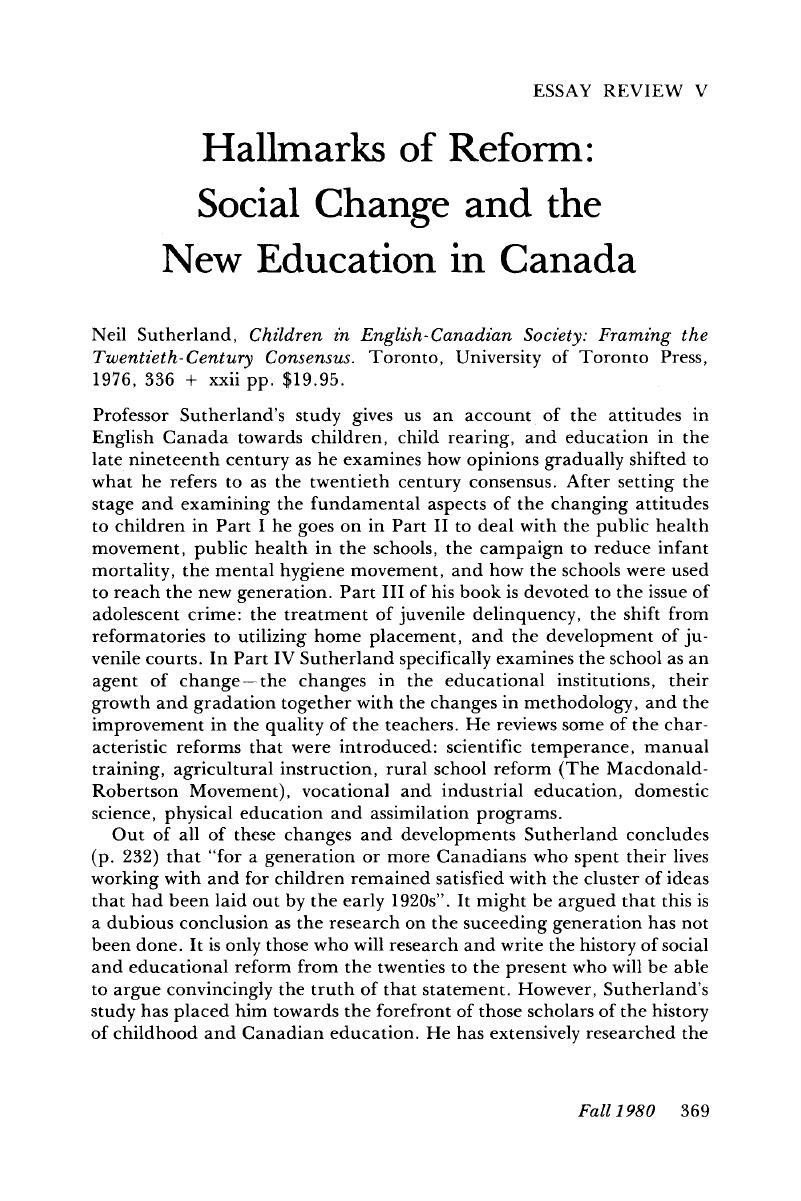No CrossRef data available.
Published online by Cambridge University Press: 24 February 2017

1. Donald Wilson, J., “The ‘New’ History of Canadian Education,” History of Education Quarterly, 16, (Fall 1976).Google Scholar
2. Macdougall, John, Rural Life In Canada Its Trends and Tasks, (Toronto, 1913).Google Scholar
3. Houston, Susan, “The Victorian Origins of Juvenile Delinquency”, The History of Education Quarterly, 12, (Fall 1972). Republished in Katz, M. B. and Mattingly, P. H. (eds.), Education and Social Change: Themes From Ontario's Past (New York, 1975).Google Scholar
4. Ibid and Prentice, A., “Education and the Metaphor of the Family: The Upper Canadian Example.” in Katz, M. B. and Mattingly, P. H. (eds.) Education and Social Change. See also Prentice, A., The School Promoters, Education and Social Class in Mid-Nineteenth Century Upper Canada, Toronto, 1977.Google Scholar
5. See Careless, J. M. S., “Frontierism, Metropolitanism and Canadian History,” in Cook, R., Brown, C. and Berger, C., (eds.), Approaches to Canadian History, (Toronto, 1967), and Careless, J. M. S. “‘Limited Identities’ in Canada” in the Canadian Historical Review, 50 (March, 1979): 1–10.Google Scholar
6. See for example a provocative article by Selden, Steven in The Educational Forum, 63 (November 1978) entitled “Eugenics and Curriculum 1860–1929:” 67–82. Since writing this argument regarding the impact of science I have read Steven Schlossman's article “End of Innocence: Science and the Transformation of Progressive Juvenile Justice, 1899–1917” History of Education 7 (1978): 207–218. Schlossman says on p. 214 “By creating new positions for themselves in family courts and public schools, the social workers hoped to place science in the service of social reform, as well, obviously, as giving themselves easy job access”.Google Scholar
7. There is Callahan, R. E., Education and Efficiency (Chicago, 1962), but research I have done on the issue of domestic science and the role of women demonstrates, quite clearly, that domestic science was to enable women to operate homes efficiently; there were also extensive arguments for industrial and agricultural efficiency.Google Scholar
8. Selleck, R.J. W., The New Education, 1870–1914 (London, 1968).Google Scholar
9. Katz, Michael, The People of Hamilton, Canada West: Family & Class in a Mid-Nineteenth Century City (Cambridge, 1975) and Houston, S., “The Impetus to Reform: Urban Crime, Poverty & Ignorance in Ontario, 1850–1875” (University of Toronto, Ph.D. thesis, 1975). Regarding the United States see Lazerson, Marvin, Origins of the Urban School: Public Education in Massachusetts, 1870–1915 (Cambridge, 1971).Google Scholar
10. There are two doctoral theses underway at the University of Toronto in the area of the public health movement.Google Scholar
11. Houston, S., “The Victorian Origins of Juvenile Delinquency”. The History of Education Quarterly, 12, (Fall, 1972).Google Scholar
12. It would be interesting to compare the ideas and interpretations of Morrison, Terrence, “The Child and Urban Social Reform in Late Nineteenth Century Ontario” (University of Toronto, Ph.D. thesis, 1971).Google Scholar